Abstract
The balance between cell proliferation and differentiation into other cell types is crucial for meristem indeterminacy, and both growth aspects are under genetic control. The peptide-receptor signaling module regulates the activity of the cambial stem cells and the differentiation of their derivatives, along with cytokinins and auxin. We identified the genes encoding the signaling module CLE41-PXY and the regulator of vascular cambium division WOX4 and studied their expression during the period of cambial growth in the radial row: the conducting phloem/cambial zone and the differentiating xylem in two forms of Betula pendula, silver birch and Karelian birch. We have shown that the expression maximum of the BpCLE41/44a gene precedes the expression maximum of the BpPXY gene. Non-figured Karelian birch plants with straight-grained wood are characterized by a more intensive growth and the high expression of CLE41/44-PXY-WOX4. Figured Karelian birch plants, where the disturbed ratio and spatial orientation of structural elements characterizes the wood, have high levels of BpWOX4 expression and a decrease in xylem growth as well as the formation of xylem with a lower vessel density. The mutual influences of CLE41-PXY signaling and auxin signaling on WOX4 gene activity and the proliferation of cambium stem cells are discussed.
1. Introduction
Radial or secondary growth promotes the formation of vascular and mechanical stem tissue. The vascular tissues ensure the transport of water, minerals, photoassimilates, and signal molecules over long distances, while the mechanical tissues ensure the maintenance of the tree in an upright state, its resistance to wind, storms, etc. Radial growth is essential for the growth of woody plants and also plays a significant role in the long-term conservation of carbon in terrestrial biomass. The whole variety of structural elements of stem tissues comprises the lateral meristem—the cambium. Vascular cambium generates the initial vascular cells and their immediate derivatives, called mother cells [1]. Although the mother amplifying cells are anatomically indistinguishable from cambial stem cells, only stem cells retain the ability to generate both secondary phloem and secondary xylem elements. These mother amplifying cells have stably gained the cell fate of one of these tissues; they may differentiate directly into different tissues or may divide several times before terminal differentiation [1,2,3,4].
The balance between cell proliferation and differentiation into other cell types is crucial for meristem indeterminacy, and both growth aspects are under genetic control [5]. CLE (CLAVATA3 (CLV3)/EMBRYO SURROUNDING REGION-RELATED) peptides of group B (CLE41, CLE44 and CLE42) are among the main development regulators of lateral meristems, along with cytokinins and auxins [5,6,7,8,9,10,11,12,13,14,15]. The first CLE-peptide involved in the control of cambium activity was isolated from the Zinnia elegans culture as a factor stimulating the proliferation of cambial cells and inhibiting the differentiation of vascular elements, which was called TDIF (Tracheary Element Differentiation Inhibitory Factor) [7,8,9,16]. TDIF is encoded by the CLE41 and CLE44 genes in the Arabidopsis genome, which are expressed mainly in the phloem tissue and neighboring cells [7,8,9,16]. Upon cleavage and modification, TDIF is presumably released into the apoplastic space and diffuses toward the cambial cells, where it is bound by the plasma membrane-associated leucine-rich repeat receptor-like kinase (LRR-RLK) protein PHLOEM INTERCALATED WITH XYLEM (PXY)/TDIF RECEPTOR (TDR) [2,7,8]. Interactions between the peptide ligand TDIF/CLE41 and the TDR/PXY receptor have three independent effects on vascular development-related processes: (1) they promote cambial cell proliferation in the procambium/cambium; (2) inhibit xylem cell differentiation; and (3) control vascular patterning [2,5,6,8,9,17,18].
WUSCHEL-RELATED HOMEOBOX4 (WOX4) and WOX14 genes involved in the regulation of cambium cell proliferation are the identified targets of the TDIF/TDR signaling pathway [2,5,8,9,10,11,19,20,21]. The CLE-PXY-WOX signaling module is important for cambium growth and development, as shown in Arabidopsis plants. Cell division orientation depends on CLE41-peptide localization: the concentration gradient TDIF is essential at the beginning of vascular development, while CLE41 expression should be limited to the phloem and adjacent cambium cells [7,13,22].
Data on the role of TDIF and their receptors (TDR) in regulating the secondary growth in woody plants are thus far scant. Such studies are not only of purely academic but also of applied value. The co-overexpression of CLE41 and PXY genes in hybrid aspen under tissue-specific promoters corresponding to the original expression domains of both genes increases wood formation [13]. Other experiments have shown that WOX4 plays a major role in controlling the cell identity and division activity in the vascular cambium of hybrid aspen [23]. The downregulation of WOX4 homologs by RNA interference in hybrid aspen causes more dramatic phenotypic changes than are observed in annual species; in the most extreme cases, the resulting reductions in cambial activity and wood formation are severe enough to prevent the trees from remaining upright [2].
Most information on the roles of CLE41/44 and PXY genes comes from studies involving their overexpression in plants or peptide treatment assays [2]. The objects of the present study were two forms of silver birch differing in wood figure: silver birch (B. pendula var. pendula), which forms a typical straight-grained wood, and a form of the silver birch, Karelian birch (B. pendula var. carelica (Merckl.) Hämet-Ahti) with figured wood. When the figured wood of Karelian birch is formed, the development program of vascular cambium cell changes: the program of cell death, leading to the formation of vessels and fibers of the xylem and sieve elements of the phloem, does not start, while the differentiating cambial derivatives preserve the protoplast and turn into storage parenchyma cells, which accumulate large amounts of storage substances [24,25,26]. The unique fact that different scenarios of xylogenesis can be studied within the same trunk makes Karelian birch a unique object for studying the mechanisms of wood formation [25,27,28].
In our previous work, we identified the genes encoding the main enzymes for auxin biosynthesis, transport, and conjugation and studied their expression models in various xylogenesis scenarios in the silver birch. We have shown that the auxin-deficient phenotype in Karelian birch trunk tissues is formed against the background of the overexpression of genes involved in auxin biosynthesis (Yucca), polar auxin transport (PIN), and the conjugation of auxin with amino acids (GH3) and UDP-glucose (UGT84B1) [26,29]. Since the TDIF/TDR-signaling influences the fate of the cambial initials and is closely related to auxin-signaling, in the present study, we focused on investigating the CLE41/44-PXY-WOX4 gene expression in the cambial zone and differentiating xylem in two forms of B. pendula: silver birch and Karelian birch.
2. Results
The study objects were two forms of silver birch: B. pendula var. pendula, the form of silver birch with a straight-grained wood (hereafter Bp trees), and another silver birch variety, B. pendula var. carelica—Karelian birch. We selected Karelian birch trees possessing a highly figured wood (figured B. pendula var. carelica trees, future Bc FT trees) and non-figured plants that had a typical straight-grained wood with a weakly expressed figure (non-figured B. pendula var. carelica trees, hereafter Bc NF trees). Previously, we showed that the studied trees differed in the structure of mature xylem. The xylem in Bp trees displayed a typical for the species ratio of structural elements [30]. The xylem in Bc FT was characterized by low vessel density, a high proportion of parenchyma, and fibrous tracheids with thick cell walls. The straight-grained wood of the Bc NF trees was characterized by a high density of vessels [30].
2.1. Description of 1 and 2 Fractions in Three Phenotypes at Different Dates of Sampling
On 28 May, fraction 1 (from the bark side) in all three groups of trees included the cambial zone, early conducting phloem (part of the conducting phloem developed in the beginning of the growing season), and a small portion of non-conducting phloem (Figure 1a–c). On 11 June, fraction 1 of the figured Karelian birch species also contained three tissues: the cambial zone, the early conductive phloem, and a small portion of the non-conductive phloem (Figure 1f). In the silver birch and non-figured Karelian birch trees, on this date, fraction 1 contained several layers of differentiating xylem closest to the cambium, aside from the three tissues above-mentioned (Figure 1d,e). The reason for the different composition of tissues in fraction 1 was the more active division of the cambium toward the xylem in two groups of trees that formed normal wood. On 26 June, fraction 1 included five tissues: several layers of the differentiating xylem closest to the cambium, the cambial zone, early conducting phloem, differentiating late conducting phloem (part of the conducting phloem developed in the second half of the growing season), and a small portion of non-conducting phloem in all three groups of trees (Figure 1g–i).
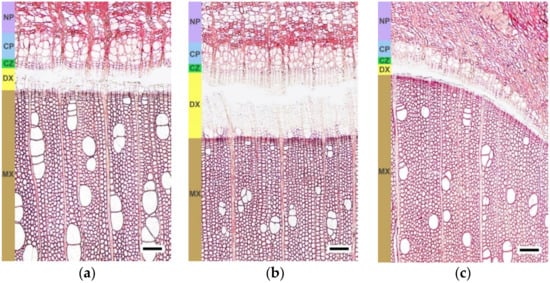
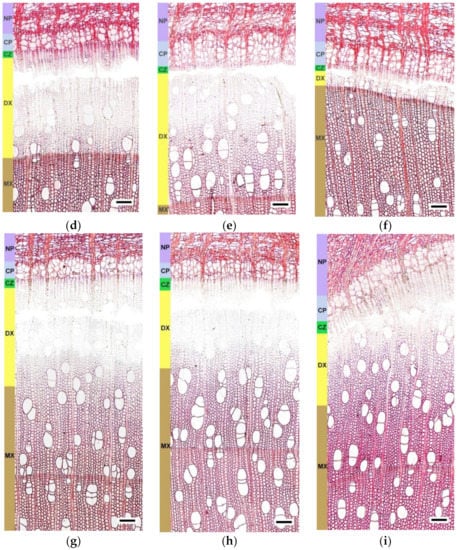
Figure 1.
The transverse sections showing the stem tissues of B. pendula var. pendula (a,d,g), non-figured (b,e,h), and figured (c,f,i) B. pendula var. carelica trees. Samples were collected on 28 May 2020 (a–c), 11 June 2020 (d–f), 25 June 2020 (g–i). NP—non-conducting phloem; CP—conducting phloem; CZ—cambial zone; DX—differentiating xylem; MX—mature xylem. Scale bar = 200 µm.
Fraction 2 (from the side of the wood) included a differentiating xylem at all periods of sampling and contained xylem cells at the stage of expansion and the formation of a secondary cell wall (Figure 1).
2.2. The Anatomical Features of the Trunk Tissues in Different Forms of Silver Birch
A few differentiating xylem cells were observed (Figure 2a) in the Bp trees (dated May 28). Every fortnight, the width of the current year xylem increment increased by 400 and 500 µm by 11 June and 25 June, respectively (Figure 2b,c). If on 11 June the entire xylem of the current year was in a differentiating state (Figure 1d), then on 25 June, most of the xylem of the current year was mature xylem (Figure 1g).
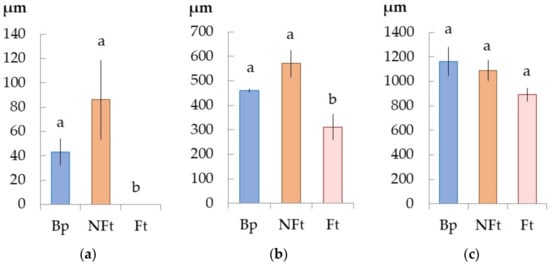
Figure 2.
The current year xylem growth ring width of B. pendula var. pendula (Bp), non-figured (NFt), and figured (Ft) B. pendula var. carelica trees. Samples were collected on 28 May 2020 (a), 11 June 2020 (b), and 25 June 2020 (c). n = 9.
The Bc NF trees (dated May 28) were characterized by the most active divisions of the cambium toward the xylem compared to the Bp trees (Figure 1a,b and Figure 2a). Over the next two weeks, the xylem increment was maximal, and xylem width increased by 580 µm by 11 June and by 450 µm by 25 June (Figure 2b,c).
The Bc FT trees were characterized by the absence of the current year xylem increment (28 May) and less xylem width (11 June) compared to the Bp and Bc NF trees (Figure 1c,f and Figure 2a,b). The increment of xylem in the current year did not significantly differ from those in the Bp and Bc NF trees by 25 June (Figure 2c).
We failed to count the number of cells in the cambial zone of the samples collected on May 28 because thin-walled and highly hydrated cells of the cambium ruptured during sampling. On 11 June, the number of cells in the cambial zone did not differ in all three studied phenotypes. Two weeks later (25 June), the number of cells of the cambial zone in the Bp and Bc NF trees decreased, especially in the Bc NF trees, while the Bc FT trees remained at the same level (Table 1).

Table 1.
The number of cells in the radial row: the cambial zone, the conducting phloem of B. pendula var. pendula (Bp), non-figured (NFt), and figured (Ft) B. pendula var. carelica trees. Samples were collected on 28 May 2020, 11 June 2020, and 25 June 2020.
As we had already observed a significant increase in the conductive phloem width in the Bp trees on 28 May, by 11 June, its value did not change and increased by 26 μm by the end of June (Figure 3). The number of differentiating phloem cells at the end of May and the middle of June was the same and increased only at the end of June. The number of sieve tubes increased by 11 June and remained at this constant level until the end of June (Table 1).
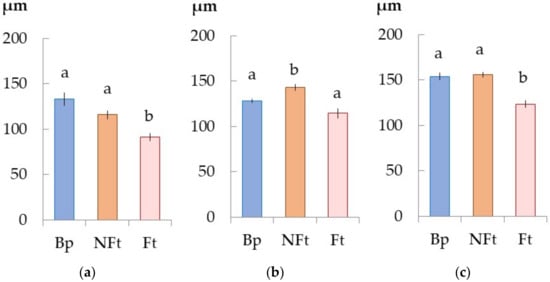
Figure 3.
The width of the conductive phloem of B. pendula var. pendula (Bp), non-figured (NFt), and figured (Ft) B. pendula var. carelica trees. Samples were collected on 28 May 2020 (a), 11 June 2020 (b), and 25 June 2020 (c). n = 9.
From 28 May to 11 June in the Bc NF trees, the width of the conducting phloem increased by 30 μm, and from 11 June to 25 June by 12 μm. The conducting phloem was wider in the Bc NF trees compared to the Bp trees only on 11 June (Figure 3). The number of differentiating phloem cells increased from 28 May to 25 June. Their number in the Bc NF trees was less than that of the Bp trees in May, and did not differ from the Bp trees on 11 June. The number of sieve tubes increased by 11 June and remained constant until 25 June, like in the Bp trees (Table 1).
2.3. CLE41/44 Gene Identification in the Silver Birch Genome
Genome-wide analysis followed by manual validation and the removal of false positives allowed us to identify two B. pendula genes encoding putative CLE41/44 proteins (Table 2). One gene was on chromosome 1, and the second on contig 443. Both genes contained one exon and had no introns (Figure 4).

Table 2.
The features of the B. pendula CLE41/44 members.

Figure 4.
The structure of the B. pendula CLE41/44 genes. The exon and untranslated region (UTR) are represented by orange boxes and blue boxes, respectively.
We found that the number of BpCLE41/44b transcripts was close to zero or not detected in all samples studied. Similar data were obtained by J. Alonso-Serra et al. [31] when studying the molecular fingerprints of eight main tissue types in the stem of B. pendula: phellem, combined phellogen and phelloderm, nonconductive secondary phloem, conductive phloem, cambium, developing xylem, xylem, and last year’s xylem tissue. The analysis of the normalized transcript abundances (TPM) for each tissue showed scanty amounts of BpCLE41/44b (Bpev01.c0443.g0012.m0001, Table S2 from [31]) in the conductive phloem and cambium. Only the BpCLE41/44a data will be discussed in this paper.
2.4. PXY Gene Identification in the Silver Birch Genome
Seven genes encoding putative receptor such as kinases homologous to TDR/PXY of other plant species (Arabidopsis thaliana and Populus trichocarpa) were identified in the B. pendula genome (Table 3). The genes were on four different chromosomes and three contigs. All genes contained two exons, except for Bpev01.c1696.g0001, which contained three exons (Figure 5).

Table 3.
The features of the B. pendula subgroup XI receptor kinase-like (RLK) family members.
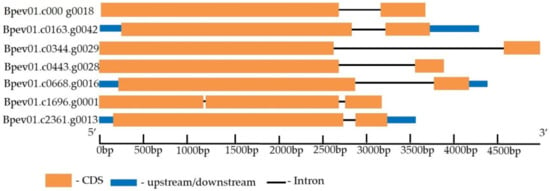
Figure 5.
The structure of B. pendula genes encoding LRR-RLKs, homologous to PXY. The intron, exon, and untranslated region (UTR) are represented by black lines, orange boxes, and blue boxes, respectively.
The phylogenetic analysis revealed that gene Bpev01.c0668.g0016 encoded the protein, which was highly similar to PXY (Figure 6). The sequence identity (in percentage of the total number of residues) for the A. thaliana PXY and B. pendula PXY protein pair was 60.5%.
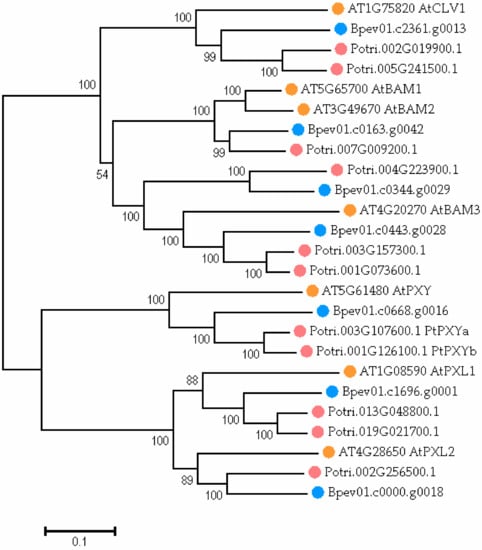
Figure 6.
The phylogenetic tree of proteins from Arabidopsis thaliana (orange dots), Populus trichocarpa (pink dots), and Betula pendula (blue dots). The tree is drawn to scale, with branch lengths in the same units as those of the evolutionary distances used to infer the phylogenetic tree. The numbers shown next to the branches represent the results of the bootstrap test (1000 replicates). The access codes of the A. thaliana and P. trichocarpa proteins in the TAIR and Phytozome databases are indicated next to the corresponding proteins.
2.5. WOX Gene Identification in the Silver Birch Genome
Eleven genes encoding putative homologous to WUSCHEL-related homeobox (WOX) transcription factors of other plant species (Arabidopsis thaliana and Populus trichocarpa) were identified in the B. pendula genome (Table 4). The genes were on seven different chromosomes and contained two to four exons (Figure 7).

Table 4.
The features of the B. pendula WUSCHEL-related homeobox (WOX) family members.
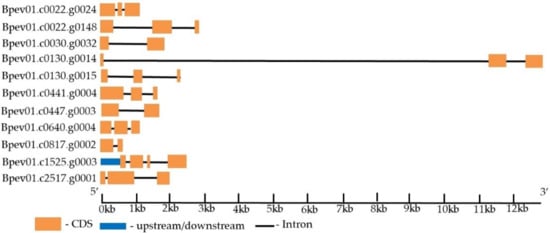
Figure 7.
The structure of the B. pendula WOX genes. The intron, exon, and untranslated region (UTR) are represented by black lines, orange boxes, and blue boxes, respectively.
Phylogenetic analysis performed on protein sequences revealed that the gene Bpev01.c0640.g0004 encoded the protein, which was highly similar to WOX4 (Figure 8). The sequence identity (in percentage of the total number of residues) for the A. thaliana WOX4 and B. pendula WOX4 protein pair was 55.6%.
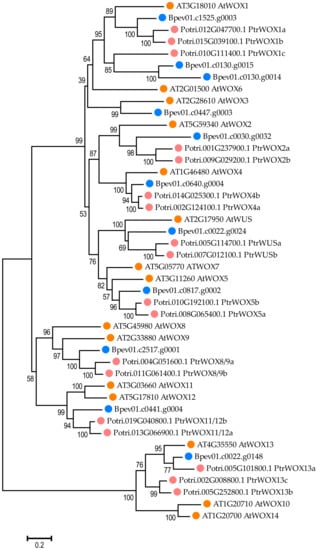
Figure 8.
The phylogenetic relationships of the WOXs of B. pendula (dark blue dots), A. thaliana (orange dots), and P. trichocarpa (pink dots). The tree was drawn to scale, with branch lengths in the same units as those of the evolutionary distances used to infer the phylogenetic tree. The numbers shown next to the branches represent the results of the bootstrap test (1000 replicates). The access codes of the A. thaliana and P. trichocarpa proteins in the TAIR and Phytozome databases are indicated next to the corresponding proteins.
2.6. Expression of the Genes Encoding CLE-PXY-WOX Signaling Pathway in the Trunk Tissues of Bp Trees during Cambial Growth
We have previously shown that WOX4 is a cambial stem cell pattern, and its activity correlates with the proliferation process [23,32]. Therefore, we used the expression level of BpWOX4 in the studied fractions to estimate cell proliferation. We found that the number of BpWOX4 transcripts in the Bp trees did not differ significantly between Fractions 1 and 2. The expression level of BpWOX4 was higher in the differentiating xylem on 28 May and 25 June, while on 11 June, it was higher in Fraction 1 in contrast (Figure 9a). We assumed that cell proliferation was observed in Fractions 1 and 2 on all sampling dates.
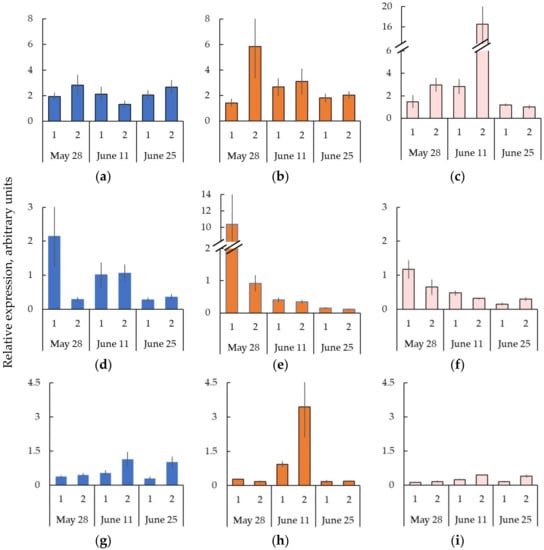
Figure 9.
The relative expression (arbitrary units) of genes BpWOX4 (a–c), BpCLE41/44a (d–f), and BpPXY (g–i) in tissues including the cambial zone, differentiating phloem, and mature phloem (1) and differentiating xylem (2) B. pendula var. pendula (a,d,g), non-figured (b,e,h), and figured (c,f,i) B. pendula var. carelica trees. Samples were collected on 28 May, 11 June, and 26 June 2020. n = 9.
The WOX4 homeodomain transcription factors are downstream targets of the TDIF/CLE41-PXY/TDR signaling pathway [9,32]. We showed that the maximum expression of BpCLE41/44a in the Bp trees was in tissues sampled from the bark side on 28 May, and its value was 10 times higher than that from the xylem side (Figure 9d). Previously, J. Alonso-Serra et al. [31] found the TPM maximum for BpCLE41/44a in non-conductive secondary phloem, conductive phloem, and cambium (Bpev01.c0016.g0065, Table S2 after [31]). At the middle and end of June, the number of BpCLE41/44a transcripts did not differ between Fractions 1 and 2. On 11 June, the expression level of BpCLE41/44a was two times higher than on June 25 (Figure 9d).
We showed that the number of BpPXY transcripts from the side of differentiating xylem compared to the tissue layer including the cambial zone and vascular phloem was higher in all trees studied. We observed the maximum at the middle and end of June (Figure 9g).
2.7. The Formation of Straight-Grained Wood of Bc NF Trees Occurs against the Background of Greater Expression of the Genes CLE-PXY-WOX in the Cambial Zone and Differentiating Xylem Compared to the Bp Trees
The maximum expression level of the genes CLE-PXY-WOX in the Bc NF trees was at the same tissues and time as in the Bp trees: for BpCLE41/44a, it was the date of 28 May, Fraction 1 (Figure 9e); for BpPXY, it was 11 June, Fraction 2 (Figure 9h); and for BpWOX4, 28 May, Fraction 2 (Figure 9b). We found that in the Bc NF trees, the expression level of BpCLE41/44a on 28 May on the bark side was five times greater compared to the Bp trees (Figure 9e), and the expression level of BpPXY (11 June) on the differentiating xylem side was three times greater (Figure 9h). The proliferation of cells (28 May) in Fraction 2 in the Bc NF trees was approximately two times higher than that in the Bp trees. The dates of 11 June and 25 June were characterized by the fact that the number of BpWOX4 transcripts decreased and did not differ between the two fractions (Figure 9b).
2.8. Decreased Expression of the Genes CLE-PXY When Forming the Wood Figure in Bc FT Trees
In the Bc FT trees, the number of BpCLE41/44a and BpPXY transcripts was lower compared to the other forms. Similar to the Bp and Bc NF trees, the maximum expression of BpCLE41/44a was observed in Fraction 1 (28 May) (Figure 9f); for BpPXY, it was the date of 11 June in Fraction 2 (Figure 9i). The lower expression of the genes CLE-PXY in the Bc FT trees, compared to the Bp and Bc NF trees, may be responsible for (1) the absence of a current year xylem increase (28 May) and the lower xylem increase (11 June) (Figure 1c,f and Figure 2a,b); and (2) the smaller width of the conducting phloem (Figure 3) and the smaller number of sieve tubes (Table 1).
Another specific feature of the Bc FT trees is the maximum cell proliferation from the xylem side (11 June), while the expression level of BpWOX4 significantly exceeded those of the Bp and Bc NF trees (Figure 9c).
3. Discussion
Plant biomass is a huge renewable resource of biofuels and biomaterials, and the major constituent of plant biomass is xylem derived from the vascular meristem [33]. Therefore, much attention has recently focused on the study of the molecular mechanisms of xylogenesis. In studies performed on Arabidopsis as the model plant, it has been shown many times that the maximum expression of CLE41/44 is observed in the phloem tissue and neighboring cells [7,9,16], while PXY and WOX4 are in part of the xylem-facing cambium [3,4]. We have shown that during the period of cambial growth in silver birch, the expression of the gene CLE-PXY-WOX patterns were extended in a radial row «the conductive phloem/the cambial zone (Fraction 1)—the differentiating xylem (Fraction 2)» with the maximum for each gene in that or another faction. The expression of the genes changed during cambial growth (28 May–25 June).
We found that the highest expression of the gene BpCLE41/44a was observed on 28 May, then decreased in all of the studied birch phenotypes (Bp, Bc NF, and Bc FT trees). In contrast, the expression levels of the gene BpPXY were the highest on 11 June. Previously, it has been shown many times in the literature that the spatial separation of the ligand (TDIF) and receptor (TDR) is necessary for the correct spatial orientation of the vascular pattern and the restriction of the stem cell zone [33]. We have shown that, together with spatial separation (Fraction 1 for BpCLE41/44a and Fraction 2 for BpPXY), we also observed temporal separation (BpCLE41/44a and BpPXY maximum at different stages of cambial growth).
In the Bp and Bc NF trees, forming straight-grained wood, the maximum expression of the gene BpWOX4 matched in time to BpCLE41/44a. Unlike BpCLE41/44a, whose peak activity was higher in Fraction 1, the maximum number of BpWOX4 transcripts was observed in Fraction 2. We have shown that the Bc NF trees, compared to Bp trees, are characterized by (1) greater expression of the genes BpCLE41/44a, BpPXY, BpWOX4; and (2) the most active divisions of the cambium toward the xylem. In our previous studies, we characterized the phenotype of the Bc NF trees as faster growing than the Bp trees. The straight-grained wood of the Bc NF trees was characterized by a high density of vessels [30].
We found that in the abnormal areas of the Karelian birch trunk, the maximum expression of the gene BpWOX4 did not coincide in time with the maximum of BpCLE41/44a and was observed on 11 June. The number of BpWOX4 transcripts significantly outnumbered those in the Bp and Bc NF trees. The expression level of the genes CLE41/44-PXY running WOX4 expression [9,32] in the Bc FT trees was significantly lower compared to the Bp and Bc NF trees.
We know that WOX4 is considered as a central regulator of vascular cambium division because it activates a cambium-specific transcriptional network and integrates TDIF/TDR signaling and auxin signaling for cambium division [9,20,34,35,36]. If TDIF/TDR signaling stimulates the WOX4 transcription and promotes the cambium proliferation in stems [9], then auxin signaling attenuates the activity of the stem cell-promoting WOX4 gene, and cell-autonomously restricts the number of stem cells in stems [34].
The TDIF/TDR signaling, aside from stimulating WOX4 transcription and promoting the cambium proliferation in stems [9], leads to the inactivation of the BES1 [37,38] and BIL1 [37,39] transcription factors. The BES1 (BRI1 (BRASSINOSTEROID INSENSITIVE)-EMSSUPPRESSOR) 1) transcription factor promotes xylem identity and also suppresses the expression of WOX4. The interaction between TDR and GSK3 (Glycogen Synthase Kinase 3) proteins (BIN2) is thought to result in the negative regulation of the BES1 by phosphorylation [37]. The BIL1 (BIN2 (BRASSINOSTEROID INSENSITIVE 2)-LIKE 1) refers to GSK3-proteins. The BIL1 links the TDIF/TDR module with auxin–cytokinin signaling during secondary growth. The BIL1 functions as a negative regulator of cambial activity downstream of the TDR by targeting the ARF5 (auxin response factor) protein [37]. Phosphorylation of ARF5 by BIL1 weakens its binding to the repressor Aux/IAA (Aux/INDOLE-3-ACETIC ACID) and enhances the negative effect ARF5 on the activity of vascular cambial, which upregulates ARR7 (ARABIDOPSIS RESPONSE REGULATOR 7) and ARR15 (two negative regulators of cytokine signaling). The BIL1 activity is inhibited by TDR, attenuating the effect of ARF5 on the expressions of ARR7 and ARR15 and increasing the vascular cambial activities [36,39,40]. High concentrations of auxin promote ubiquitin-mediated proteolysis of Aux/IAA transcriptional repressors, releasing ARF5 to regulate xylem differentiation. ARF5 autonomously limits the number of stem cells through the weakening of WOX4 activity and increases the expression of the HB8 gene, positively affecting xylem differentiation [2,41] (Figure 10).
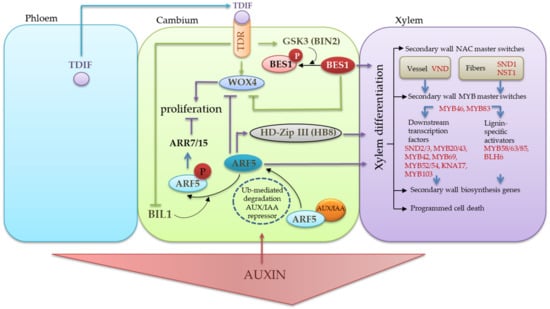
Figure 10.
The schematic representation of the hormonal and molecular genetic regulation of cambium activity in woody plants. The TDIF signal peptide is produced in the phloem and migrates to the cambium, where it binds to its TDR receptor. The TDIF/TDR signaling activates WOX4 by regulating cambium cell proliferation [4,12,23]. TDIF binding to TDR activates GSK3 (BIN2) and leads to the phosphorylation and degradation of the BES1 protein. BES1 promotes xylem differentiation and also suppresses WOX4 expression, so its degradation preserves cambium pluripotency [37]. The TRD acts as a suppressor of another GSK3—BIN2-LIKE 1 (BIL1). BIL1 in the absence of TDR phosphorylates the auxin-dependent transcription factor of ARF5, releasing it by weakening the interaction of ARF5 with the AUX/IAA repressor [40]. Phosphorylation of ARF5 enhances its activity in suppressing the cytokine response through the expression of ARR7/15 and leads to a decrease in cambium proliferation [39]. Auxin signal transduction in cambial stem cells is required to maintain cambial activity [20]. The level of auxin signal transmission increases in the differentiating xylem. High concentrations of auxin promote the ubiquitin-mediated proteolysis of Aux/IAA transcriptional repressors, releasing ARF5 to regulate xylem differentiation. ARF5 autonomously limits the number of stem cells by downregulating the WOX4 activity and increasing the HB8 gene expression, positively influencing xylem differentiation [2].
From this, it follows that (1) the presence of a high expression of CLE41/44-PXY and/or (2) reduced auxin signaling is necessary to maintain a high expression of the gene BpWOX4. We have previously investigated the expression level of BpARF5 and its direct target, BpHB8, in the trunk tissues of different forms of silver birch [30]. We found that the level of BpARF5 expression in the differentiating xylem of Karelian birch plants with both figured and non-figured wood was lower than in the Bp trees. The formation of the figured wood of the Bc FT trees was associated with the low expression of BpHB8, whereas in the Bc NF trees with a straight-grained wood, the expression of BpHB8 was indistinguishable from that of the Bp trees [30]. Collectively, the data obtained through this study and previous ones allow us to propose that the maximum expression of the gene BpWOX4 in Bc FT trees on 11 June was due to (1) continuing TDIF/TDR signaling and (2) reduced auxin signaling. This suggestion is consistent with the anatomical evidence of lower xylem increases in the Bc FT trees compared to the Bp and Bc NF trees.
4. Materials and Methods
4.1. Study Objects
The study objects were two forms of silver birch: Betula pendula Roth var. pendula—the form of silver birch with straight-grained wood, and B. pendula var. carelica—Karelian birch. All plants grew in the same soil and climatic conditions on the experimental plot of the KarRC RAS near Petrozavodsk city. The trees were 14–15 years old. The Karelian birch plants were grown from seeds obtained from the controlled pollination of Karelian birch plus trees. The number of trees in each group was nine. The samples were collected during the period of cambial growth (28 May 2020, 11 June 2020, and 26 June 2020).
4.2. Plant Sampling
The trunk tissue samples were taken at breast height (1.3 m above ground level). The sections of the trunk with the highest degree of manifestation of structural anomalies were selected for the sampling of plant material from the Karelian birch trunks. For microscopic analysis blocks including the phloem, the cambial zone and the last 2–3 annual increments of wood were cut out (5 × 5 × 3 mm, length x width x height). For molecular genetic analysis, «windows» of 6 × 8 cm were cut out of the trunk and the bark was separated from the wood (Figure 11). During the period of cambial growth, the bark moves away from the wood along the expanding xylem zone. Tissue complexes (hereafter Fraction 1) were prepared from the inner surface of the bark. The layers of tissue (hereafter Fraction 2) were scraped off the exposed wood surface with a blade. The sampling of stem tissues was monitored under a light microscope (Figure 1). The material was frozen in liquid nitrogen and stored at −80 °C.
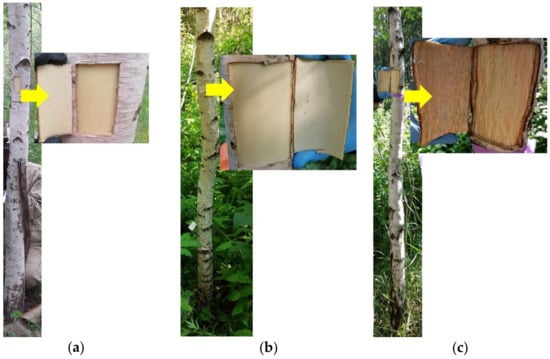
Figure 11.
The trunk, debarked wood surface, and inner bark surface of B. pendula var. pendula (a), non-figured (b), and figured (c) B. pendula var. carelica trees.
4.3. Microscopy
Three samples of phloem and xylem tissues from each tree were analyzed. Sample preparation for microscopy was conducted as described previously [26]. The samples were fixed in glutaraldehyde, dehydrated in a series of alcohols of rising concentrations, and embedded in an Araldite-Embed-812 mixture following the published technique [42]. Cross sections 2 µm thick were cut with an Ultrotome IV (LKB, Bromma, Sweden) and stained with a 1% aqueous solution of safranin. Permanent slides were made using synthetic mounting medium Vitrogel (BioVitrum, St. Petersburg, Russia). Microscopic analysis was carried out under an AxioImager A1 light microscope (Carl Zeiss, Jena, Germany) equipped with an ADF PRO03 camera. Images were processed with ADF Image Capture software (ADF Optics Ningbo, China). Anatomical measurements were made following the available guidelines using panoramic cross sections with an area of 7–10 mm2 [43,44,45].
4.4. Gene Retrieval from the Silver Birch Genome by Bioinformatics Methods
The search for the CLE41/44, PXY, and WOX4 genes was carried out using the published genome of Betula pendula Roth [46]. To this end, the CDS of Arabidopsis thaliana and Populus trichocarpa CLE41/44, the PXY and WOX4 genes, and the amino acid sequences of the corresponding proteins were obtained from The Arabidopsis Information Resource (TAIR) database (release 13, https://www.arabidopsis.org, accessed on 20 April 2020) and the Phytozome database (http://www.phytozome.net/poplar, release v3.0, accessed on 20 April 2020), respectively. The resulting sequences were then used as a BLAST search query across the genome of B. pendula var. pendula (release 1.2, https://genomevolution.org/coge, accessed on 20 April 2020) to identify homologous sequences.
The structures of candidate proteins were predicted using the National Center for Biotechnology Information (NCBI) resource (http://www.ncbi.nlm.nih.gov/Structure/cdd/cdd.shtml, accessed on 20 April 2020) [47]. The prediction of protein subcellular localization was performed using DeepLoc 2.0 [48]. Phylogenetic analysis was carried out using MEGA X software [49]. Multiple sequence alignment of the protein sequences was performed using ClustalW. Phylogenetic trees were constructed using the neighbor-joining method based on the Poisson correction model with 1000 bootstrap replicates [50,51,52]. The different genes in B. pendula were named according to the Phylogenetic analysis. The percent identity of B. pendula and A. thaliana proteins was determined using the EMBOSS Needle online tool (https://www.ebi.ac.uk/Tools/psa/emboss_needle/, accessed on 20 April 2020). The gene structures were analyzed using the Gene Structure Display Server (//gsds.gao-lab.org/, accessed on 20 April 2020) [53].
4.5. qRT-PCR
The isolation of total RNA was performed using an extraction CTAB buffer (pH 4.8–5.0): 100 mM Tris–HCl (pH 8.0), 25 mM EDTA, 2M NaCl, 2% CTAB, 2% PVP, and 2% mercaptethanol was added to the mixture before use. Plant tissue lysates were additionally treated with DNase and RNase inhibitors (Syntol, Moscow, Russia). Separation of the aqueous and organic phases was conducted using a mixture of chloroform–isoamyl alcohol (24:1). RNA was precipitated using 25 mM LiCl, then re-precipitation was carried out using an extraction SDS buffer: 1 M NaCl, 0.5% SDS, 10 mM Tris–HCl (pH 8.0), 1 mM EDTA [54]. RNA was re-precipitated with absolute isopropanol. The quality and quantity of the isolated RNA and synthesized cDNA were checked spectrophotometrically and by electrophoresis in 1% agarose gel.
Specific primers (Sintol, Moscow, Russia) for amplification of the studied genes were designed using the software Beacon Designer 8.21 (PREMIER Biosoft, San Francisco, CA, USA) (Table 5). As a reference gene for the normalization of quantitative PCR data, we used genes of the Ef1a and GAPDH family [55].

Table 5.
The list of primers for the RT-PCR reaction.
In previous studies, we evaluated the suitability of five genes—GAPDH1, Actin1, Ef1a(1), Ef1a(2), and 18SrRNA—in two forms of silver birch for use as a reference when staging qRT-PCR based on the stability of their expression. The results of studying the level of expression of the potential reference genes were analyzed using the NormFinder and BestKeeper programs. We showed that among the studied genes, the most stably expressed in the B. pendula samples (leaves and trunk tissues) were Actin1, GAPDH1, and Ef1a(1), while the GAPDH1 and Ef1a(1) genes were suggested by NormFinder as the best combination of two reference genes and had the lowest stability index [55]. Families of genes coding for (1) peptide ligand TDIF/CLE41 (BpCLE41/44a and BpCLE41/44b); (2) the TDR/PXY receptor (BpPXY); and (3) WUSCHEL-RELATED HOMEOBOX4 (BpWOX4) involved in the regulation of cambium cell proliferation as the identified targets of the TDIF/TDR signaling pathway were studied.
Amplification of the samples was performed using an iCycler instrument with an iQ5 optical module (Bio-Rad, Hercules CA, USA) and an amplification kit with an intercalating dye SYBR Green (Evrogen, Moscow, Russia). The specificity of the amplification products was checked by melting the PCR fragments. The relative quantity of gene transcripts (RQ) was calculated from the formula:
where ΔCt is the difference in the threshold cycle values for the reference and target genes, and E is the effectiveness of PCR. To determine the efficiency (E), PCR amplification was performed with each pair of primers in a series of 10-fold dilutions (10−1, 10−2, 10−3, 10−4, and 10−5) of cDNA. Using Excel software, a plot of Ct versus Lg (conc. cDNA) was plotted, and using the values of the slope of the curve (slope, k), the efficiency was calculated using the formula [56]:
RQ = E−ΔCt,
E = (10−1/K − 1) × 100.
The level of expression of specific genes was expressed in relative units (arbitrary units).
4.6. Statistical Data Processing
The results were statistically processed with PAST (version 4.0). Before starting the statistical analysis, raw data were initially tested for normality using the Shapiro–Wilk test. The significance of differences between variants was estimated by the Mann–Whitney U-test. Different letters indicate a significant difference at p < 0.05. All data in the diagrams appear as mean ± SE, where SE is the standard error. Sample sizes are denoted as n.
The research was carried out using the equipment of the Core Facility of the Karelian Research Center of the Russian Academy of Sciences.
5. Conclusions
The distribution of the expression of the genes CLE-PXY-WOX was studied during the period of cambial growth in the radial row: the conducting phloem/cambial zone and the differentiating xylem under different scenarios of xylogenesis using two forms of silver birch as an example. We showed that the expression maximum of the CLE41/44 and PXY genes are separated not only in space (conductive phloem/cambial zone (Fraction 1)—differentiating xylem (Fraction 2)), but also in time. The expression maximum of the BpCLE41/44a gene precedes the expression maximum of the BpPXY gene. TDIF/TDR signaling induces BpWOX4 gene expression and stem cell proliferation in the cambium. Thus, the phenotype of the Bc NF trees with high expression of CLE41/44-PXY-WOX4 is characterized by more intensive growth. Auxin signaling against the background of a decrease in the expression of the CLE41/44 genes leads to a decrease in the expression of the BpWOX4 genes, and, accordingly, the proliferation of cambial initials. The auxin-deficient phenotypes of Bc FT trees showed high levels of BpWOX4 expression and a decrease in xylem growth as well as the formation of xylem with a lower vessel density. A significant decrease in free (physiologically active) auxin because of its conjugation with UDP-glucose and amino acids described previously [26,29] may lead to more dramatic scenarios in the Bc FT trees in the zones of development of structural abnormalities; the differentiating cambial derivatives preserve the protoplast and turn into the storage parenchyma cells.
Author Contributions
Conceptualization, N.A.G. and Y.L.M.; Methodology, N.A.G., Y.L.M. and T.V.T.; Validation, K.M.N.; Formal analysis, O.V.C., A.A.S., L.I.S. and D.S.I.; Investigation, N.A.G.; Data curation, N.A.G., Y.L.M., T.V.T. and K.M.N.; Writing—original draft preparation, N.A.G.; Writing—review and editing, Y.L.M., T.V.T. and K.M.N.; Visualization, L.I.S.; Supervision, N.A.G.; Project administration, N.A.G.; Funding acquisition, N.A.G. All authors have read and agreed to the published version of the manuscript.
Funding
The study was funded under state order to the Karelian Research Center of the Russian Academy of Sciences (Forest Research Institute KRC).
Institutional Review Board Statement
Not applicable.
Informed Consent Statement
Not applicable.
Data Availability Statement
Not applicable.
Conflicts of Interest
The authors declare no conflict of interest.
References
- Evert, R.F.; Eichhorn, S.E. Esau’s Plant Anatomy: Meristems, Cells, and Tissues of the Plant Body: Their Structure, Function, and Development, 3rd ed.; Wiley-Interscience: Hoboken, NJ, USA, 2006; ISBN 978-0-471-73843-5. [Google Scholar]
- Fischer, U.; Kucukoglu, M.; Helariutta, Y.; Bhalerao, R.P. The Dynamics of Cambial Stem Cell Activity. Annu. Rev. Plant Biol. 2019, 70, 293–319. [Google Scholar] [CrossRef] [PubMed]
- Shi, D.; Lebovka, I.; López-Salmerón, V.; Sanchez, P.; Greb, T. Bifacial Cambium Stem Cells Generate Xylem and Phloem during Radial Plant Growth. Development 2019, 146, dev171355. [Google Scholar] [CrossRef] [PubMed]
- Smetana, O.; Mäkilä, R.; Lyu, M.; Amiryousefi, A.; Sánchez Rodríguez, F.; Wu, M.-F.; Solé-Gil, A.; Leal Gavarrón, M.; Siligato, R.; Miyashima, S.; et al. High Levels of Auxin Signalling Define the Stem-Cell Organizer of the Vascular Cambium. Nature 2019, 565, 485–489. [Google Scholar] [CrossRef] [PubMed]
- Nieminen, K.; Blomster, T.; Helariutta, Y.; Mähönen, A.P. Vascular Cambium Development. Arab. Book 2015, 13, e0177. [Google Scholar] [CrossRef]
- Schrader, J.; Baba, K.; May, S.T.; Palme, K.; Bennett, M.; Bhalerao, R.P.; Sandberg, G. Polar Auxin Transport in the Wood-Forming Tissues of Hybrid Aspen Is under Simultaneous Control of Developmental and Environmental Signals. Proc. Natl. Acad. Sci. USA 2003, 100, 10096–10101. [Google Scholar] [CrossRef]
- Etchells, J.P.; Turner, S.R. The PXY-CLE41 Receptor Ligand Pair Defines a Multifunctional Pathway That Controls the Rate and Orientation of Vascular Cell Division. Development 2010, 137, 767–774. [Google Scholar] [CrossRef]
- Hirakawa, Y.; Kondo, Y.; Fukuda, H. Regulation of Vascular Development by CLE Peptide-Receptor Systems. J. Integr. Plant Biol. 2010, 52, 8–16. [Google Scholar] [CrossRef]
- Hirakawa, Y.; Kondo, Y.; Fukuda, H. TDIF Peptide Signaling Regulates Vascular Stem Cell Proliferation via the WOX4 Homeobox Gene in Arabidopsis. Plant Cell 2010, 22, 2618–2629. [Google Scholar] [CrossRef]
- Betsuyaku, S.; Takahashi, F.; Kinoshita, A.; Miwa, H.; Shinozaki, K.; Fukuda, H.; Sawa, S. Mitogen-Activated Protein Kinase Regulated by the CLAVATA Receptors Contributes to Shoot Apical Meristem Homeostasis. Plant Cell Physiol. 2011, 52, 14–29. [Google Scholar] [CrossRef]
- Katsir, L.; Davies, K.A.; Bergmann, D.C.; Laux, T. Peptide Signaling in Plant Development. Curr. Biol. 2011, 21, R356–R364. [Google Scholar] [CrossRef]
- Etchells, J.P.; Provost, C.M.; Turner, S.R. Plant Vascular Cell Division Is Maintained by an Interaction between PXY and Ethylene Signalling. PLoS Genet. 2012, 8, e1002997. [Google Scholar] [CrossRef] [PubMed]
- Etchells, J.P.; Mishra, L.S.; Kumar, M.; Campbell, L.; Turner, S.R. Wood Formation in Trees Is Increased by Manipulating Pxy-Regulated Cell Division. Curr. Biol. 2015, 25, 1050–1055. [Google Scholar] [CrossRef] [PubMed]
- Dodueva, I.E.; Yurlova, E.V.; Osipova, M.A.; Lutova, L.A. CLE Peptides Are Universal Regulators of Meristem Development. Russ. J. Plant Physiol. 2012, 59, 14–27. [Google Scholar] [CrossRef]
- Dodueva, I.E.; Gancheva, M.S.; Osipova, M.A.; Tvorogova, V.E.; Lutova, L.A. Lateral Meristems of Higher Plants: Phytohormonal and Genetic Control. Russ. J. Plant Physiol. 2014, 61, 571–589. [Google Scholar] [CrossRef]
- Ito, Y.; Nakanomyo, I.; Motose, H.; Iwamoto, K.; Sawa, S.; Dohmae, N.; Fukuda, H. Dodeca-CLE Peptides as Suppressors of Plant Stem Cell Differentiation. Science 2006, 313, 842–845. [Google Scholar] [CrossRef] [PubMed]
- Hirakawa, Y.; Shinohara, H.; Kondo, Y.; Inoue, A.; Nakanomyo, I.; Ogawa, M.; Sawa, S.; Ohashi-Ito, K.; Matsubayashi, Y.; Fukuda, H. Non-Cell-Autonomous Control of Vascular Stem Cell Fate by a CLE Peptide/Receptor System. Proc. Natl. Acad. Sci. USA 2008, 105, 15208–15213. [Google Scholar] [CrossRef]
- Lehesranta, S.J.; Lichtenberger, R.; Helariutta, Y. Cell-to-Cell Communication in Vascular Morphogenesis. Curr. Opin. Plant Biol. 2010, 13, 59–65. [Google Scholar] [CrossRef]
- Schrader, J.; Moyle, R.; Bhalerao, R.; Hertzberg, M.; Lundeberg, J.; Nilsson, P.; Bhalerao, R.P. Cambial Meristem Dormancy in Trees Involves Extensive Remodelling of the Transcriptome. Plant J. 2004, 40, 173–187. [Google Scholar] [CrossRef]
- Suer, S.; Agusti, J.; Sanchez, P.; Schwarz, M.; Greb, T. WOX4 Imparts Auxin Responsiveness to Cambium Cells in Arabidopsis. Plant Cell 2011, 23, 3247–3259. [Google Scholar] [CrossRef]
- Ye, Z.-H.; Zhong, R. Molecular Control of Wood Formation in Trees. J. Exp. Bot. 2015, 66, 4119–4131. [Google Scholar] [CrossRef]
- Fisher, K.; Turner, S. PXY, a Receptor-like Kinase Essential for Maintaining Polarity during Plant Vascular-Tissue Development. Curr. Biol. 2007, 17, 1061–1066. [Google Scholar] [CrossRef] [PubMed]
- Kucukoglu, M.; Nilsson, J.; Zheng, B.; Chaabouni, S.; Nilsson, O. WUSCHEL-RELATED HOMEOBOX4 (WOX4)-like Genes Regulate Cambial Cell Division Activity and Secondary Growth in Populus Trees. New Phytol. 2017, 215, 642–657. [Google Scholar] [CrossRef] [PubMed]
- Novitskaya, L.; Nikolaeva, N.; Tarelkina, T. Endogenous Variability of the Figured Wood of Karelian Birch. Wulfenia 2016, 23, 175–188. [Google Scholar]
- Novitskaya, L.L.; Shulyakovskaya, T.A.; Galibina, N.A.; Ilyinova, M.K. Membrane Lipid Composition upon Normal and Patterned Wood Formation in Betula Pendula Roth. J. Plant Growth Regul. 2018, 37, 958–970. [Google Scholar] [CrossRef]
- Novitskaya, L.L.; Tarelkina, T.V.; Galibina, N.A.; Moshchenskaya, Y.L.; Nikolaeva, N.N.; Nikerova, K.M.; Podgornaya, M.N.; Sofronova, I.N.; Semenova, L.I. The Formation of Structural Abnormalities in Karelian Birch Wood Is Associated with Auxin Inactivation and Disrupted Basipetal Auxin Transport. J. Plant Growth Regul. 2020, 39, 378–394. [Google Scholar] [CrossRef]
- Lyubavskaya, A.Y. Karelian Birch; Publishing House of Moscow State Forest University: Moscow, Russia, 2006. [Google Scholar]
- Novitskaya, L.; Nikolaeva, N.; Galibina, N.; Tarelkina, T.; Semenova, L. The Greatest Density of Parenchyma Inclusions in Karelian Birch Wood Occurs at Confluences of Phloem Flows. Silva Fenn. 2016, 50, 1461–1478. [Google Scholar] [CrossRef][Green Version]
- Tarelkina, T.V.; Novitskaya, L.L.; Galibina, N.A.; Moshchenskaya, Y.L.; Nikerova, K.M.; Nikolaeva, N.N.; Sofronova, I.N.; Ivanova, D.S.; Semenova, L.I. Expression Analysis of Key Auxin Biosynthesis, Transport, and Metabolism Genes of Betula Pendula with Special Emphasis on Figured Wood Formation in Karelian Birch. Plants 2020, 9, 1406. [Google Scholar] [CrossRef]
- Galibina, N.A.; Tarelkina, T.V.; Chirva, O.V.; Moshchenskaya, Y.L.; Nikerova, K.M.; Ivanova, D.S.; Semenova, L.I.; Serkova, A.A.; Novitskaya, L.L. Molecular Genetic Characteristics of Different Scenarios of Xylogenesis on the Example of Two Forms of Silver Birch Differing in the Ratio of Structural Elements in the Xylem. Plants 2021, 10, 1593. [Google Scholar] [CrossRef]
- Alonso-Serra, J.; Safronov, O.; Lim, K.; Fraser-Miller, S.J.; Blokhina, O.B.; Campilho, A.; Chong, S.; Fagerstedt, K.; Haavikko, R.; Helariutta, Y.; et al. Tissue-specific Study across the Stem Reveals the Chemistry and Transcriptome Dynamics of Birch Bark. New Phytol. 2019, 222, 1816–1831. [Google Scholar] [CrossRef]
- Etchells, J.P.; Provost, C.M.; Mishra, L.; Turner, S.R. WOX4 and WOX14 Act Downstream of the PXY Receptor Kinase to Regulate Plant Vascular Proliferation Independently of Any Role in Vascular Organisation. Development 2013, 140, 2224–2234. [Google Scholar] [CrossRef]
- Etchells, J.P.; Smit, M.E.; Gaudinier, A.; Williams, C.J.; Brady, S.M. A Brief History of the TDIF-PXY Signalling Module: Balancing Meristem Identity and Differentiation during Vascular Development. New Phytol. 2016, 209, 474–484. [Google Scholar] [CrossRef] [PubMed]
- Brackmann, K.; Qi, J.; Gebert, M.; Jouannet, V.; Schlamp, T.; Grünwald, K.; Wallner, E.-S.; Novikova, D.D.; Levitsky, V.G.; Agustí, J.; et al. Spatial Specificity of Auxin Responses Coordinates Wood Formation. Nat. Commun. 2018, 9, 875. [Google Scholar] [CrossRef] [PubMed]
- Zhang, J.; Eswaran, G.; Alonso-Serra, J.; Kucukoglu, M.; Xiang, J.; Yang, W.; Elo, A.; Nieminen, K.; Damén, T.; Joung, J.-G.; et al. Transcriptional Regulatory Framework for Vascular Cambium Development in Arabidopsis Roots. Nat. Plants 2019, 5, 1033–1042. [Google Scholar] [CrossRef] [PubMed]
- Wang, D.; Chen, Y.; Li, W.; Li, Q.; Lu, M.; Zhou, G.; Chai, G. Vascular Cambium: The Source of Wood Formation. Front. Plant Sci. 2021, 12, 700928. [Google Scholar] [CrossRef]
- Kondo, Y.; Ito, T.; Nakagami, H.; Hirakawa, Y.; Saito, M.; Tamaki, T.; Shirasu, K.; Fukuda, H. Plant GSK3 Proteins Regulate Xylem Cell Differentiation Downstream of TDIF–TDR Signalling. Nat. Commun. 2014, 5, 3504. [Google Scholar] [CrossRef]
- Hu, J.; Hu, X.; Yang, Y.; He, C.; Hu, J.; Wang, X. Strigolactone Signaling Regulates Cambial Activity through Repression of WOX4 by Transcription Factor BES1. Plant Physiol. 2022, 188, 255–267. [Google Scholar] [CrossRef]
- Han, S.; Cho, H.; Noh, J.; Qi, J.; Jung, H.-J.; Nam, H.; Lee, S.; Hwang, D.; Greb, T.; Hwang, I. BIL1-Mediated MP Phosphorylation Integrates PXY and Cytokinin Signalling in Secondary Growth. Nat. Plants 2018, 4, 605–614. [Google Scholar] [CrossRef]
- Bagdassarian, K.S.; Brown, C.M.; Jones, E.T.; Etchells, P. Connections in the Cambium, Receptors in the Ring. Curr. Opin. Plant Biol. 2020, 57, 96–103. [Google Scholar] [CrossRef]
- Xu, C.; Shen, Y.; He, F.; Fu, X.; Yu, H.; Lu, W.; Li, Y.; Li, C.; Fan, D.; Wang, H.C.; et al. Auxin-mediated Aux/IAA-ARF-HB Signaling Cascade Regulates Secondary Xylem Development in Populus. New Phytol. 2019, 222, 752–767. [Google Scholar] [CrossRef]
- Mollenhauer, H.H. Plastic Embedding Mixtures for Use in Electron Microscopy. Stain Technol. 1964, 39, 111–114. [Google Scholar]
- IAWA List of Microscopic Features for Hardwood Identification. IAWA Bull. 1989, 10, 219–332.
- Scholz, A.; Klepsch, M.; Karimi, Z.; Jansen, S. How to Quantify Conduits in Wood? Front. Plant Sci. 2013, 4, 56. [Google Scholar] [CrossRef] [PubMed]
- Angyalossy, V.; Pace, M.R.; Evert, R.F.; Marcati, C.R.; Oskolski, A.A.; Terrazas, T.; Kotina, E.; Lens, F.; Mazzoni-Viveiros, S.C.; Angeles, G.; et al. IAWA List of Microscopic Bark Features. IAWA J. 2016, 37, 517–615. [Google Scholar] [CrossRef]
- Salojärvi, J.; Smolander, O.-P.; Nieminen, K.; Rajaraman, S.; Safronov, O.; Safdari, P.; Lamminmäki, A.; Immanen, J.; Lan, T.; Tanskanen, J.; et al. Genome Sequencing and Population Genomic Analyses Provide Insights into the Adaptive Landscape of Silver Birch. Nat. Genet. 2017, 49, 904–912. [Google Scholar] [CrossRef] [PubMed]
- Marchler-Bauer, A.; Bryant, S.H. CD-Search: Protein Domain Annotations on the Fly. Nucleic Acids Res. 2004, 32, W327–W331. [Google Scholar] [CrossRef] [PubMed]
- Thumuluri, V.; Almagro Armenteros, J.J.; Johansen, A.R.; Nielsen, H.; Winther, O. DeepLoc 2.0: Multi-Label Subcellular Localization Prediction Using Protein Language Models. Nucleic Acids Res. 2022, gkac278. [Google Scholar] [CrossRef] [PubMed]
- Kumar, S.; Stecher, G.; Li, M.; Knyaz, C.; Tamura, K. MEGA X: Molecular Evolutionary Genetics Analysis across Computing Platforms. Mol. Biol. Evol. 2018, 35, 1547–1549. [Google Scholar] [CrossRef]
- Felsenstein, J. Confidence Limits on Phylogenies: An Approach Using the Bootstrap. Evolution 1985, 39, 783–791. [Google Scholar] [CrossRef]
- Saitou, N.; Nei, M. The Neighbor-Joining Method: A New Method for Reconstructing Phylogenetic Trees. Mol. Biol. Evol. 1987, 4, 406–425. [Google Scholar] [CrossRef]
- Nei, M.; Kumar, S. Molecular Evolution and Phylogenetics; Oxford University Press: Oxford, UK; New York, NY, USA, 2000; ISBN 978-0-19-513584-8. [Google Scholar]
- Hu, B.; Jin, J.; Guo, A.-Y.; Zhang, H.; Luo, J.; Gao, G. GSDS 2.0: An Upgraded Gene Feature Visualization Server. Bioinformatics 2015, 31, 1296–1297. [Google Scholar] [CrossRef]
- Xu, M.; Zang, B.; Yao, H.S.; Huang, M.R. Isolation of High Quality RNA and Molecular Manipulations with Various Tissues of Populus. Russ. J. Plant Physiol. 2009, 56, 716–719. [Google Scholar] [CrossRef]
- Moshchenskaya, Y.L.; Galibina, N.A.; Tarelkina, T.V.; Nikerova, K.M.; Chirva, O.V.; Novitskaya, L.L. Selection of Reference Genes for Normalization of Quantitative PCR Data in Real Time in Two Forms of Silver Birch. Russ. J. Plant Physiol. 2021, 68, 214–221. [Google Scholar] [CrossRef]
- Chang, E.; Shi, S.; Liu, J.; Cheng, T.; Xue, L.; Yang, X.; Yang, W.; Lan, Q.; Jiang, Z. Selection of Reference Genes for Quantitative Gene Expression Studies in Platycladus Orientalis (Cupressaceae) Using Real-Time PCR. PLoS ONE 2012, 7, e33278. [Google Scholar] [CrossRef] [PubMed]
Publisher’s Note: MDPI stays neutral with regard to jurisdictional claims in published maps and institutional affiliations. |
© 2022 by the authors. Licensee MDPI, Basel, Switzerland. This article is an open access article distributed under the terms and conditions of the Creative Commons Attribution (CC BY) license (https://creativecommons.org/licenses/by/4.0/).